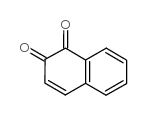1,2-NAPHTHOQUINONE

1,2-NAPHTHOQUINONE structure
|
Common Name | 1,2-NAPHTHOQUINONE | ||
|---|---|---|---|---|
| CAS Number | 524-42-5 | Molecular Weight | 158.15300 | |
| Density | 1.29g/cm3 | Boiling Point | N/A | |
| Molecular Formula | C10H6O2 | Melting Point | 139-142 °C (dec.)(lit.) | |
| MSDS | Chinese USA | Flash Point | 117.4ºC | |
| Symbol |

GHS07 |
Signal Word | Warning | |
|
A chemical screening approach reveals that indole fluorescence is quenched by pre-fibrillar but not fibrillar amyloid-beta.
Bioorg. Med. Chem. Lett. 19 , 4952-7, (2009) Aggregated amyloid-beta (Abeta) peptide is implicated in the pathology of Alzheimer's disease. In vitro and in vivo, these aggregates are found in a variety of morphologies, including globular oligomers and linear fibrils, which possess distinct biological ac... |
|
|
A new method and tool for detection and quantification of PM oxidative potential.
Environ. Sci. Pollut. Res. Int. 22 , 12469-78, (2015) Airborne particulate matter (PM) contains several quinones, which are able to generate reactive oxygen species impacting on cell viability. A method able to detect and quantify PM oxidative potential, based on the cytochrome c (cyt-c) reduction by means of su... |
|
|
Indoleamine 2,3-dioxygenase is the anticancer target for a novel series of potent naphthoquinone-based inhibitors.
J. Med. Chem. 51 , 1706-18, (2008) Indoleamine 2,3-dioxygenase (IDO) is emerging as an important new therapeutic target for the treatment of cancer, chronic viral infections, and other diseases characterized by pathological immune suppression. While small molecule inhibitors of IDO exist, ther... |
|
|
Glutathione-mediated reversibility of covalent modification of ubiquitin carboxyl-terminal hydrolase L1 by 1,2-naphthoquinone through Cys152, but not Lys4
Chem. Biol. Interact. 214 , 41-8, (2014) • Exposure of SH-SY5Y cells to 1,2-NQ caused covalent modification of UCH-L1. • UCH-L1 undergoes arylation by 1,2-NQ, thereby decreasing its activity. • UCH-L1 Cys152 arylation by 1,2-NQ is reversible via GSH-mediated S-transarylation. • Lys4 modification in ... |
|
|
Small molecule inhibitors of aggregation indicate that amyloid beta oligomerization and fibrillization pathways are independent and distinct.
J. Biol. Chem. 282 , 10311-24, (2007) Alzheimer disease is characterized by the abnormal aggregation of amyloid beta peptide into extracellular fibrillar deposits known as amyloid plaques. Soluble oligomers have been observed at early time points preceding fibril formation, and these oligomers ha... |
|
|
Efficient generation of ortho-naphthoquinone methides from 1,4-epoxy-1,4-dihydronaphthalenes and their annulation with allyl silanes.
Angew. Chem. Int. Ed. Engl. 52(5) , 1515-9, (2013)
|
|
|
Reduction of lipid peroxidation products and advanced glycation end-product precursors by cyanobacterial aldo-keto reductase AKR3G1—a founding member of the AKR3G subfamily.
FASEB J. 29(1) , 263-73, (2015) The purpose of this study was to investigate the origin and function of the aldo-keto reductase (AKR) superfamily as enzymes involved in the detoxification of xenobiotics. We used the cyanobacterium Synechocystis sp. PCC 6803 as a model organism and sequence ... |
|
|
1,2-naphthoquinone stimulates lipid peroxidation and cholesterol domain formation in model membranes.
Invest. Ophthalmol. Vis. Sci. 54(12) , 7189-97, (2013) Naphthalene induces cataract formation through the accumulation of its reactive metabolite, 1,2-naphthoquinone (1,2-NQ), in the ocular lens. 1,2-NQ increases lens protein oxidation and disrupts fiber cell membrane function; however, the association of these e... |
|
|
Peroxiredoxin 6 is a molecular target for 1,2-naphthoquinone, an atmospheric electrophile, in human pulmonary epithelial A549 cells.
J. Toxicol. Sci. 36(6) , 817-21, (2011) 1,2-Naphthoquinone (1,2-NQ) is an electrophile found in the atmosphere, which reacts readily with protein nucleophiles to form a stable protein adduct. Peroxiredoxin 6 (Prdx6) is predominantly expressed in lung tissue and functions in antioxidant defense by f... |
|
|
Effects of different quinoid redox mediators on the simultaneous removal of p-cresol and sulphide in a denitrifying process.
Water Sci. Technol. 59(10) , 1945-50, (2009) The catalytic effects of different quinoid redox mediators (RM) on the simultaneous removal of sulphide and p-cresol in a denitrifying process were evaluated in batch studies. 2-Hydroxy-1,4-naphthoquinone (LAW) and anthraquinone-2,6-disulphonate (AQDS) did no... |